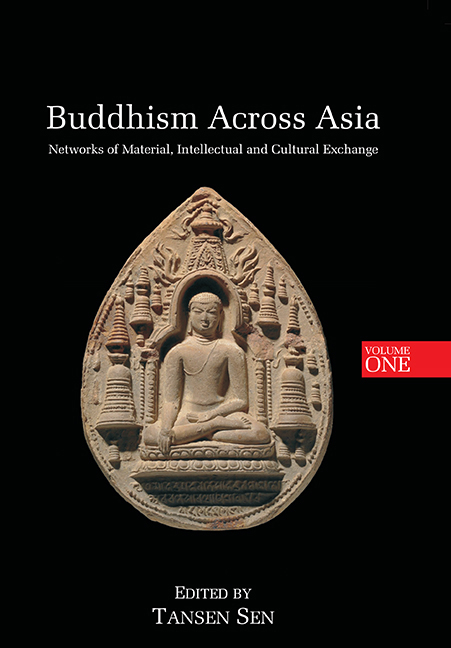Book contents
- Frontmatter
- Dedication
- Contents
- Introduction: Buddhism in Asian History
- Part I Tran smissions of Buddhism Before the Seventh Century
- Part II Buddhism Across Asia between the Seventh and Fifteenth Centuries
- 8 On Kuiji's Sanskrit Compound Analyses: Transmission of Sanskrit Grammar in the Early Tang Dynasty
- 9 Abridged Teaching (Lüe Jiao): Monastic Rules between India and China
- 10 From Nālandā to Chang'an: A Survey of Buddhist Libraries in Medieval China (618-907)
- 11 Multiple Traditions in One Ritual: A Reading of the Lantern-Lighting Prayers in Dunhuang Manuscripts
- 12 The Idea of India (Tenjiku) in Pre-Modern Japan: Issues of Signification and Representation in the Buddhist Translation of Cultures
- 13 The Buddhist Image Inside-Out: On the Placing of Objects Inside Statues in East Asia
- 14 Indian Abhidharma Literature in Tibet: A Study of the Vijñāna Section of Sthiramati's Pañcaskandhakavibhāṣā
- 15 From Aśoka to Jayavarman VII: Some Reflections on the Relationship between Buddhism and the State in India and Southeast Asia
- 16 The Theravāda Buddhist Ecumene in the Fifteenth Century: Intellectual Foundations and Material Representations
- Part III Buddhist Connections after the Fifteenth Century
- List of Contributors
- Index
- Miscellaneous Endmatter
16 - The Theravāda Buddhist Ecumene in the Fifteenth Century: Intellectual Foundations and Material Representations
from Part II - Buddhism Across Asia between the Seventh and Fifteenth Centuries
Published online by Cambridge University Press: 21 October 2015
- Frontmatter
- Dedication
- Contents
- Introduction: Buddhism in Asian History
- Part I Tran smissions of Buddhism Before the Seventh Century
- Part II Buddhism Across Asia between the Seventh and Fifteenth Centuries
- 8 On Kuiji's Sanskrit Compound Analyses: Transmission of Sanskrit Grammar in the Early Tang Dynasty
- 9 Abridged Teaching (Lüe Jiao): Monastic Rules between India and China
- 10 From Nālandā to Chang'an: A Survey of Buddhist Libraries in Medieval China (618-907)
- 11 Multiple Traditions in One Ritual: A Reading of the Lantern-Lighting Prayers in Dunhuang Manuscripts
- 12 The Idea of India (Tenjiku) in Pre-Modern Japan: Issues of Signification and Representation in the Buddhist Translation of Cultures
- 13 The Buddhist Image Inside-Out: On the Placing of Objects Inside Statues in East Asia
- 14 Indian Abhidharma Literature in Tibet: A Study of the Vijñāna Section of Sthiramati's Pañcaskandhakavibhāṣā
- 15 From Aśoka to Jayavarman VII: Some Reflections on the Relationship between Buddhism and the State in India and Southeast Asia
- 16 The Theravāda Buddhist Ecumene in the Fifteenth Century: Intellectual Foundations and Material Representations
- Part III Buddhist Connections after the Fifteenth Century
- List of Contributors
- Index
- Miscellaneous Endmatter
Summary
INTRODUCTION
Buddhism, and no less so Theravāda Buddhism, has been a transnational movement right from its beginning. The Mauryan king, Aśoka's sending of monks to the regions adjacent to India in the third century bce is a well-known and oft-quoted example, and the spread of Buddhist texts and artefacts in subsequent centuries has been the subject of numerous studies. This expansion to the east culminated in the period between c. 800 and 1200 ce, when Buddhism gradually disappeared in its Indian homeland but simultaneously resurged as a mass religion in mainland Southeast Asia. It is important to note that this relationship was by no means unilinear, as Buddhists from outside South Asia regularly returned to the “Middle Country” to visit its sacred places, study in one of its monastic centres such as Nālandā or Anurādhapura, and exchange ideas, texts, ordination lineages and all kinds of artefacts.
At the heart of this exchange system lies the Bay of Bengal. Ever since Fernand Braudel's pioneering study of the Mediterranean, historians have recognised that the sea cannot only separate people but also bring them together and provide for the transfer of goods and ideas, as well as facilitate any other sort of exchange and communication. The ocean as a platform for intercourse, exchange and communication in all their forms – one could as well call it a “sea square” for this purpose – has thrilled historians ever since, making the study of oceans and their sub-systems, as well as the social and economic networks which they bear, an important field of historical research. Even though it is less closed than the Mediterranean, the Bay of Bengal seems to fit Braudel's model quite well. Landlocked on its northern and eastern sides, the Bay is open on its southern side, opening not only the Indian east coast for communication with Southeast Asia, but also serving as a link between the Indian Ocean in the west and the China Sea in the east. This maritime route was part of the larger “silk road of the sea,” which stretched from China through Southeast Asian waters and the Malacca Straits to south India into the Indian Ocean and further west towards the Red Sea and the east coast of Africa.
- Type
- Chapter
- Information
- Buddhism Across AsiaNetworks of Material, Intellectual and Cultural Exchange, volume 1, pp. 347 - 368Publisher: ISEAS–Yusof Ishak InstitutePrint publication year: 2014

